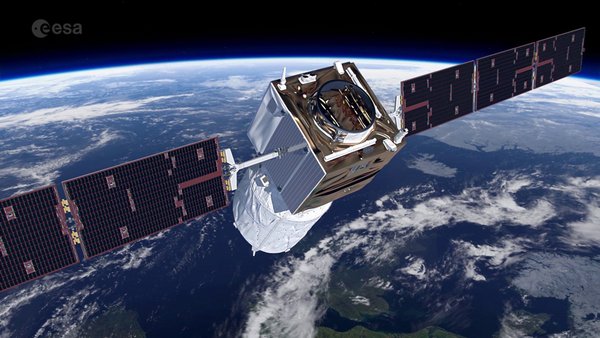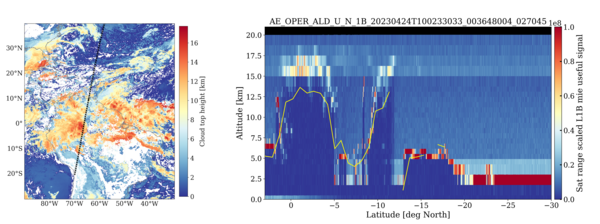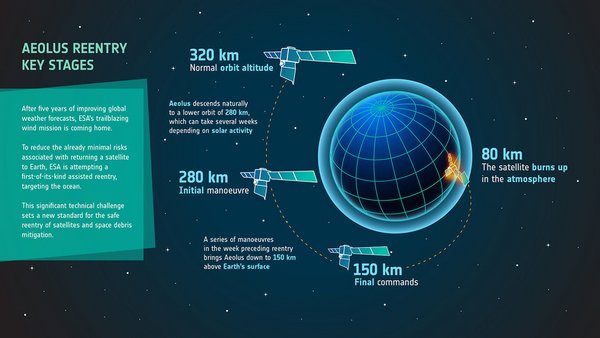Last experiments of the Aeolus satellite for TROPOS before re-entry into the Earth's atmosphere
Leipzig,
28.07.2023
TROPOS involvement throughout the mission and preparations for the upcoming EarthCARE mission.
Darmstadt/Leipzig. After completing a very successful mission, ESA’s Aeolus satellite is on its descent from 320 km altitude back to Earth’s atmosphere. While the satellite would usually fall down slowly due to the Earth’s gravity, ESA is attempting to return Aeolus in an controlled reentry (Read more via ESA:: https://www.esa.int/Applications/Observing_the_Earth/FutureEO/Aeolus/Guiding_Aeolus_safe_reentry). The final manoeuvres for this reentry are happing right now and can be followed here: https://blogs.esa.int/rocketscience/2023/07/24/aeolus-reentry-live/ . On this occasion, a brief review of scientific experiments which happened shortly before the end of Aeolus’ mission life in which the Leibniz Institute for Tropospheric Research (TROPOS) was involved:
TROPOS involvement throughout the whole mission
Launched on 22 August 2018, the satellite was orbiting the Earth for almost five years while providing vertical profiles of the horizontal wind speed and backscatter information on clouds and aerosols. TROPOS strongly contributed to the great success of the mission while providing continuous reference measurements all over the world for validation of the wind and aerosol/cloud products from the beginning until the end of the mission. Also beyond the mission, TROPOS will be involved within the Aeolus Data, Innovation and Science Cluster (DISC) project to improve the data products and enhance the scientific impact of the mission. TROPOS took part in the Level-2A aerosol optical properties product development, monitoring the data quality and supporting external validation with science team from European partners.
End of life tests
Before the satellite is now coming back, the Aeolus team has successfully conducted a series of end of life experiments. The scientists hope that the results of these experiments help improving future lidar missions in space. The radiometric performance of the instrument and the impact on both aerosol and wind products were assessed in collaboration with the Aeolus DISC for each test.
Vertical winds
TROPOS was involved in one experiment where the laser was tilted from its nominal 35 degrees diagonal view to a nadir view (point on the Earth’s surface directly beneath the satellite) to measure vertical winds over deep convective cloud systems. While vertical air motions are negligible on average over large horizontal scales, this assumption is not valid in situations with strong convection (e.g., tropical storms). “While we are still analysing the promising data collected during this test, we hope that we can quantify the impact of vertical air motions on the assumptions that are using,” says Dr Sebastian Bley of TROPOS.
ATLID test
TROPOS was also involved in an ATLID test, where the Aeolus laser ALADIN was configured in a way to mimic the ATLID lidar, which will fly on EarthCARE. This test is intended to prepare for the upcoming EarthCARE satellite which will carry a lidar instrument very similar to that flying on Aeolus. „Lessons learned from Aeolus helped us a lot in preparing for the EarthCARE mission. With its four instruments on one platform for measuring aerosols, clouds, and radiation, it is even more challenging than Aeolus,” says Dr Ulla Wandinger of TROPOS. The launch window for the EarthCARE mission is currently scheduled for April-June 2024. While performing the ATLID test, Aeolus was flying over Leipzig and Mindelo at Cape Verde Islands, both stations with ground-based lidar instruments operated by TROPOS.
Final statement by TROPOS
We are following the Aeolus reentry with mixed feelings, on one hand we are sad about the fact that this wonderful satellite will burn in Earth’s atmosphere in the coming days, while on the other hand we are pleased and proud that we could contribute to the success of this exciting mission.
But there is also reason to look into a bright future. Our work will continue also after Aeolus illuminates the sky like a falling star for a last time. Our colleagues at TROPOS will continue working on the Aeolus data from the last five years within the Aeolus DISC project, notably validating the reprocessed aerosol products and highlighting novel applications for the atmospheric science community. Furthermore, we are heavily involved in the preparation for the upcoming EarthCARE mission, which will be launched in summer next year. TROPOS has a leading role in the developments of the processors for the ATLID lidar and the cloud products for the Multi-Spectral Imager (MSI) within the frame of the ESA-CARDINAL project. Furthermore, TROPOS is preparing for the validation of the EarthCARE measurements with our ground-based measurements sites of the whole globe.
Publications
Wandinger, U., Floutsi, A. A., Baars, H., Haarig, M., Ansmann, A., Hünerbein, A., Docter, N., Donovan, D., van Zadelhoff, G.-J., Mason, S., and Cole, J.: HETEAC – the Hybrid End-To-End Aerosol Classification model for EarthCARE, Atmos. Meas. Tech., 16, 2485–2510, https://doi.org/10.5194/amt-16-2485-2023, 2023. Published: 25 May 2023
This research was supported by the European Space Agency (grants no. 4000112018/14/NL/CT (APRIL) and 4000134661/21/NL/AD (CARDINAL)).
Hünerbein, A., Bley, S., Horn, S., Deneke, H., and Walther, A.: Cloud mask algorithm from the EarthCARE Multi-Spectral Imager: the M-CM products, Atmos. Meas. Tech., 16, 2821–2836, https://doi.org/10.5194/amt-16-2821-2023 , 2023.
The research was funded by the European Space Agency (ESA) (grant nos. 4000112018/14/NL/CT (APRIL) and 4000134661/21/NL/AD (CARDINAL)). The publication of this article was funded by the Open Access Fund of the Leibniz Association.
Baars, H., Walchester, J., Basharova, E., Gebauer, H., Radenz, M., Bühl, J., Barja, B., Wandinger, U., and Seifert, P.: Long-term validation of Aeolus L2B wind products at Punta Arenas, Chile and Leipzig, Germany, Atmos. Meas. Tech. Discuss. [preprint], https://doi.org/10.5194/amt-2022-331, in review, 2022.
This research has been supported by the German Federal Ministry for Economic Affairs and Energy (BMWi) (grant no. 50EE1721C), the European Union’s Horizon 2020 research and innovation programme (ACTRIS-2 under grant agreement no. 654109) and the European Union’s Horizon 2020 – Research and Innovation Framework Programme (ACTRIS PPP, H2020-INFRADEV-575 2016-2017, Grant Agreement number: 7395302).
Wandinger, U., Haarig, M., Baars, H., Donovan, D., and van Zadelhoff, G.-J.: Cloud top heights and aerosol layer properties from EarthCARE lidar observations: the A-CTH and A-ALD products, EGUsphere [preprint], https://doi.org/10.5194/egusphere-2023-748, 2023.
This research has been funded by ESA grants 4000112018/14/NL/CT (APRIL) and 4000134661/21/NL/AD (CARDINAL).
Contacts:
Dr Sebastian Bley / Dr Dmitri Trapon / Dr Holger Baars / Dr Ulla Wandinger
TROPOS Department "Remote Sensing of Atmospheric Processes"
Phone +49-341-2717-7171, -7082
https://www.tropos.de/en/institute/about-us/employees/sebastian-bley
https://www.tropos.de/institut/ueber-uns/mitarbeitende/holger-baars
www.tropos.de/institut/ueber-uns/mitarbeitende/ulla-wandinger
or
Tilo Arnhold, TROPOS public relations
Phone +49-341-2717-7189
https://www.tropos.de/en/current-issues/press-releases
Links:
By ESA:
Aeolus reentry: live
https://blogs.esa.int/rocketscience/2023/07/24/aeolus-reentry-live/
Guiding Aeolus' safe re-entry
https://www.esa.int/Applications/Observing_the_Earth/FutureEO/Aeolus/Guiding_Aeolus_safe_reentry
By TROPOS:
Loon stratospheric balloons confirm wind data from Aeolus (media release, 20 Dec 2022): https://www.tropos.de/en/current-issues/press-releases/details/loon-stratosphaerenballons-bestaetigen-winddaten-von-aeolus
Large measurement campaign in the Atlantic starts (media release, 30 Jun 2021):
https://www.tropos.de/en/current-issues/press-releases/details/grosse-messkampagne-im-atlantik-laeuft-an
Californian smoke drifted as far as Central Europe in autumn 2020 and caused heavy clouding of the sun (media release, 01 Jun 2021):
https://www.tropos.de/en/current-issues/press-releases/details/kalifornischer-rauch-zog-im-herbst-2020-bis-nach-mitteleuropa-und-sorgte-fuer-starke-truebung-der-sonne
ADM Aeolus – Measuring the wind from space with a laser for the first time (media release, 21 Aug 2018): https://www.tropos.de/en/current-issues/press-releases/details/adm-aeolus-measuring-the-wind-from-space-with-a-laser-for-the-first-time
The Leibniz Institute for Tropospheric Research (TROPOS) is a member of the Leibniz Association, which connects 97 independent research institutions that range in focus from the natural, engineering and environmental sciences via economics, spatial and social sciences to the humanities. Leibniz Institutes address issues of social, economic and ecological relevance. They conduct knowledge-driven and applied basic research, maintain scientific infrastructure and provide research-based services.
The Leibniz Association identifies focus areas for knowledge transfer to policy-makers, academia, business and the public. Leibniz institutions collaborate intensively with universities – in the form of “Leibniz ScienceCampi” (thematic partnerships between university and non-university research institutes), for example – as well as with industry and other partners at home and abroad.
They are subject to an independent evaluation procedure that is unparalleled in its transparency. Due to the importance of the institutions for the country as a whole, they are funded jointly by the Federation and the Länder, employing some 20,500 individuals, including 11,500 researchers.
The entire budget of all the institutes is approximately 2 billion euros. They are financed jointly by the Federal Government and the Länder. The basic funding of the Leibniz Institute for Tropospheric Research (TROPOS) is therefore financed by the Federal Ministry of Education and Research (BMBF) and the Saxon State Ministry of Science and the Arts (SMWK). The Institute is co-financed with tax revenues on the basis of the budget approved by the Saxon State Parliament.
www.leibniz-gemeinschaft.de/en/home/
www.bmbf.de/en/index.html
https://www.smwk.sachsen.de/



